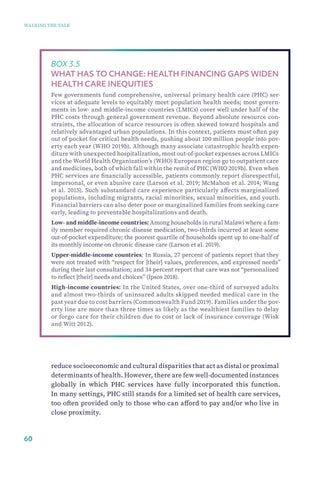WALKING THE TALK
BOX 3.5 WHAT HAS TO CHANGE: HEALTH FINANCING GAPS WIDEN HEALTH CARE INEQUITIES Few governments fund comprehensive, universal primary health care (PHC) services at adequate levels to equitably meet population health needs; most governments in low- and middle-income countries (LMICs) cover well under half of the PHC costs through general government revenue. Beyond absolute resource constraints, the allocation of scarce resources is often skewed toward hospitals and relatively advantaged urban populations. In this context, patients must often pay out of pocket for critical health needs, pushing about 100 million people into poverty each year (WHO 2019b). Although many associate catastrophic health expenditure with unexpected hospitalization, most out-of-pocket expenses across LMICs and the World Health Organization’s (WHO) European region go to outpatient care and medicines, both of which fall within the remit of PHC (WHO 2019b). Even when PHC services are financially accessible, patients commonly report disrespectful, impersonal, or even abusive care (Larson et al. 2019; McMahon et al. 2014; Wang et al. 2015). Such substandard care experience particularly affects marginalized populations, including migrants, racial minorities, sexual minorities, and youth. Financial barriers can also deter poor or marginalized families from seeking care early, leading to preventable hospitalizations and death. Low- and middle-income countries: Among households in rural Malawi where a family member required chronic disease medication, two-thirds incurred at least some out-of-pocket expenditure; the poorest quartile of households spent up to one-half of its monthly income on chronic disease care (Larson et al. 2019). Upper-middle-income countries: In Russia, 27 percent of patients report that they were not treated with “respect for [their] values, preferences, and expressed needs” during their last consultation; and 34 percent report that care was not “personalized to reflect [their] needs and choices” (Ipsos 2018). High-income countries: In the United States, over one-third of surveyed adults and almost two-thirds of uninsured adults skipped needed medical care in the past year due to cost barriers (Commonwealth Fund 2019). Families under the poverty line are more than three times as likely as the wealthiest families to delay or forgo care for their children due to cost or lack of insurance coverage (Wisk and Witt 2012).
reduce socioeconomic and cultural disparities that act as distal or proximal determinants of health. However, there are few well-documented instances globally in which PHC services have fully incorporated this function. In many settings, PHC still stands for a limited set of health care services, too often provided only to those who can afford to pay and/or who live in close proximity.
60


